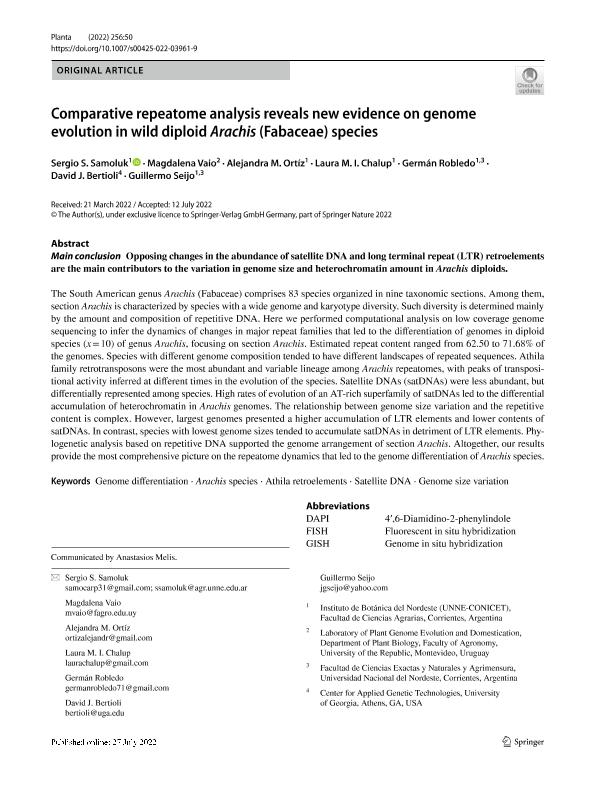Mostrar el registro sencillo del ítem
dc.contributor.author
Samoluk, Sergio Sebastián

dc.contributor.author
Vaio, Magdalena
dc.contributor.author
Ortiz, Alejandra Marcela

dc.contributor.author
Chalup, Laura María Isabel

dc.contributor.author
Robledo Dobladez, Germán Ariel

dc.contributor.author
Bertioli, David J.
dc.contributor.author
Seijo, José Guillermo

dc.date.available
2023-10-17T13:40:24Z
dc.date.issued
2022-07
dc.identifier.citation
Samoluk, Sergio Sebastián; Vaio, Magdalena; Ortiz, Alejandra Marcela; Chalup, Laura María Isabel; Robledo Dobladez, Germán Ariel; et al.; Comparative repeatome analysis reveals new evidence on genome evolution in wild diploid Arachis (Fabaceae) species; Springer; Planta; 256; 3; 7-2022; 1-18
dc.identifier.issn
0032-0935
dc.identifier.uri
http://hdl.handle.net/11336/215137
dc.description.abstract
The South American genus Arachis (Fabaceae) comprises 83 species organized in nine taxonomic sections. Among them,section Arachis is characterized by species with a wide genome and karyotype diversity. Such diversity is determined mainlyby the amount and composition of repetitive DNA. Here we performed computational analysis on low coverage genomesequencing to infer the dynamics of changes in major repeat families that led to the differentiation of genomes in diploidspecies (x = 10) of genus Arachis, focusing on section Arachis. Estimated repeat content ranged from 62.50 to 71.68% ofthe genomes. Species with different genome composition tended to have different landscapes of repeated sequences. Athilafamily retrotransposons were the most abundant and variable lineage among Arachis repeatomes, with peaks of transpositionalactivity inferred at different times in the evolution of the species. Satellite DNAs (satDNAs) were less abundant, butdifferentially represented among species. High rates of evolution of an AT-rich superfamily of satDNAs led to the differentialaccumulation of heterochromatin in Arachis genomes. The relationship between genome size variation and the repetitivecontent is complex. However, largest genomes presented a higher accumulation of LTR elements and lower contents ofsatDNAs. In contrast, species with lowest genome sizes tended to accumulate satDNAs in detriment of LTR elements. Phylogeneticanalysis based on repetitive DNA supported the genome arrangement of section Arachis. Altogether, our resultsprovide the most comprehensive picture on the repeatome dynamics that led to the genome differentiation of Arachis species.
dc.format
application/pdf
dc.language.iso
eng
dc.publisher
Springer

dc.rights
info:eu-repo/semantics/openAccess
dc.rights.uri
https://creativecommons.org/licenses/by-nc-sa/2.5/ar/
dc.subject
ARACHIS SPECIES
dc.subject
ATHILA RETROELEMENTS
dc.subject
GENOME DIFFERENTIATION
dc.subject
GENOME SIZE VARIATION
dc.subject
SATELLITE DNA
dc.subject.classification
Genética y Herencia

dc.subject.classification
Ciencias Biológicas

dc.subject.classification
CIENCIAS NATURALES Y EXACTAS

dc.title
Comparative repeatome analysis reveals new evidence on genome evolution in wild diploid Arachis (Fabaceae) species
dc.type
info:eu-repo/semantics/article
dc.type
info:ar-repo/semantics/artículo
dc.type
info:eu-repo/semantics/publishedVersion
dc.date.updated
2023-10-12T11:28:00Z
dc.journal.volume
256
dc.journal.number
3
dc.journal.pagination
1-18
dc.journal.pais
Alemania

dc.journal.ciudad
Berlin
dc.description.fil
Fil: Samoluk, Sergio Sebastián. Consejo Nacional de Investigaciones Científicas y Técnicas. Centro Científico Tecnológico Conicet - Nordeste. Instituto de Botánica del Nordeste. Universidad Nacional del Nordeste. Facultad de Ciencias Agrarias. Instituto de Botánica del Nordeste; Argentina
dc.description.fil
Fil: Vaio, Magdalena. Universidad de la Republica; Uruguay
dc.description.fil
Fil: Ortiz, Alejandra Marcela. Consejo Nacional de Investigaciones Científicas y Técnicas. Centro Científico Tecnológico Conicet - Nordeste. Instituto de Botánica del Nordeste. Universidad Nacional del Nordeste. Facultad de Ciencias Agrarias. Instituto de Botánica del Nordeste; Argentina
dc.description.fil
Fil: Chalup, Laura María Isabel. Consejo Nacional de Investigaciones Científicas y Técnicas. Centro Científico Tecnológico Conicet - Nordeste. Instituto de Botánica del Nordeste. Universidad Nacional del Nordeste. Facultad de Ciencias Agrarias. Instituto de Botánica del Nordeste; Argentina
dc.description.fil
Fil: Robledo Dobladez, Germán Ariel. Consejo Nacional de Investigaciones Científicas y Técnicas. Centro Científico Tecnológico Conicet - Nordeste. Instituto de Botánica del Nordeste. Universidad Nacional del Nordeste. Facultad de Ciencias Agrarias. Instituto de Botánica del Nordeste; Argentina
dc.description.fil
Fil: Bertioli, David J.. University of Georgia; Estados Unidos
dc.description.fil
Fil: Seijo, José Guillermo. Consejo Nacional de Investigaciones Científicas y Técnicas. Centro Científico Tecnológico Conicet - Nordeste. Instituto de Botánica del Nordeste. Universidad Nacional del Nordeste. Facultad de Ciencias Agrarias. Instituto de Botánica del Nordeste; Argentina
dc.journal.title
Planta

dc.relation.alternativeid
info:eu-repo/semantics/altIdentifier/url/https://link.springer.com/article/10.1007/s00425-022-03961-9
dc.relation.alternativeid
info:eu-repo/semantics/altIdentifier/doi/http://dx.doi.org/10.1007/s00425-022-03961-9
Archivos asociados
